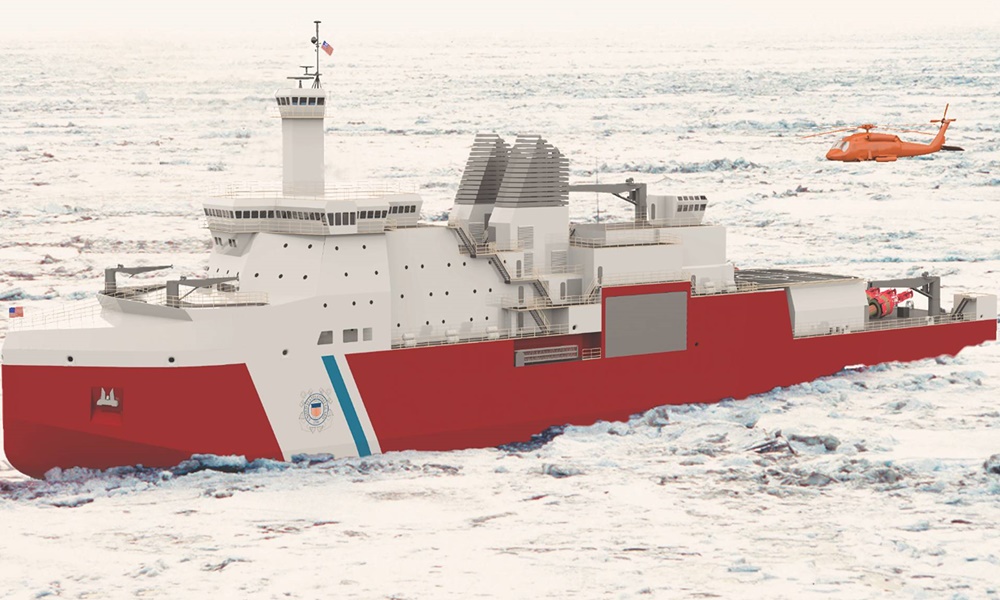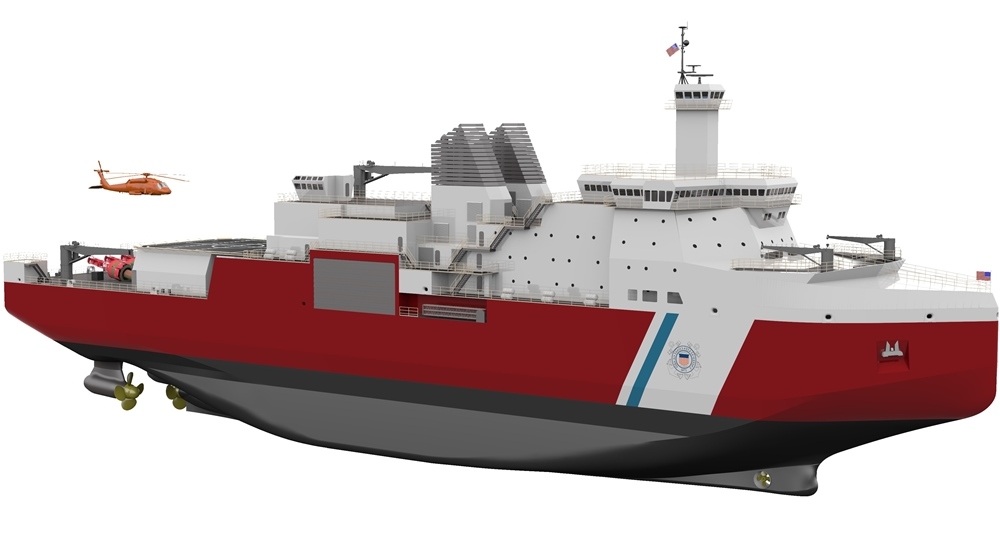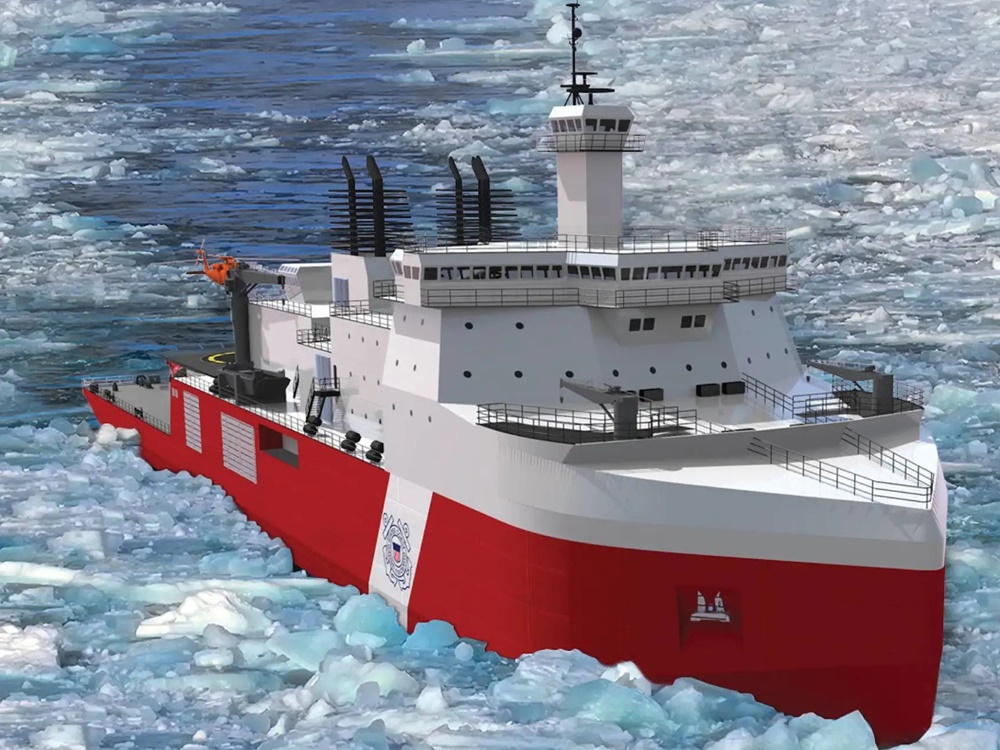USCGC Polar Sentinel icebreaker
Former name: WMSP-21
Cruise line
USCG-US Coast Guard (Icebreakers)
Specifications of USCGC Polar Sentinel icebreaker
| Year of build | 2028 new ship |
| Builder | VT Halter Marine (Pascagoula, Mississippi USA) Bollinger Shipyards |
| Class | USCG Polar Security Cutter / Polar Class 2 Icebreaker |
| Ferry route / homeports | Seattle, Washington USA |
| Building cost | USD 745,9 million (EUR 671 million / GBP 574 million) |
| Engines (power) | MAK-Caterpillar (33.7 MW / 45192 hp) |
| Speed | 16 kn / 30 km/h / 18 mph |
| Length (LOA) | 140 m / 459 ft |
| Beam (width) | 27 m / 89 ft |
| Gross Tonnage | 14300 gt |
| Passengers | 142 |
| Crew | 44 |
| Former names | WMSP-21 |
| Christened by | tba |
| Owner | USA government (via United States Armed Forces) |
| Operator | USCG (United States Coast Guard) |
USCGC Polar Sentinel icebreaker Review
Review of USCGC Polar Sentinel icebreaker
USCGC Polar Sentinel is the first in a three-ship series of American polar icebreakers of the new "Polar Security Cutter" heavy icebreakers (Polar Class 2) owned by the USA's government and operated by the USCG (branch of the US Armed Forces). "USCGC" stands for "United States Coast Guard Cutter". The term "cutter" is used for all USCG-commissioned ships with minimum LOA length 65 ft (19,8 m) and permanently crewed (with assigned personnel accommodated in shipboard cabins).
USCGC Polar Sentinel is currently under construction and scheduled for commissioning in 2028 (postponed from May 2025). The second icebreaker (yet to be named) was initially planned for completion in September 2026. A third (optional/if ordered) sistership was to be delivered by the end of 2027. However, Polar Sentinel's/PSC's design approval was delayed (postponed to 2024) and the first vessel from the series will be commissioned sometime in 2028.
The vessel (IMO number tba) will be USA-flagged (MMSI tba) and homeported in Seattle WA.
Polar Security Cutter Program (history and updates)
The USA's "Polar Security Cutter Program" is a 2012-launched (as PIB/ Polar Icebreaker) program (fiscal year/FY2013 budget submission) of the USCG (United States Coast Guard) and the USN (United States Navy) to replace the USA's aging icebreaker fleet with three newbuild "Polar Security Cutters" (PSC/multimission icebreaking vessels).

Until 2025 (when the first unit will be commissioned), the USCG has in operation only two icebreakers - USCGC Polar Star (1973-built, Project WAGB-10/"heavy icebreaker") and USCGC Healy (2000-built, Project WAGB-20/"medium icebreaker").
The new (Polar Security) icebreakers are classified by the USCG as "heavy icebreakers" and are intended to support the agency's statutory Arctic missions as well as USAP (United States Antarctic Program) and Antarctic Service (1959-founded government organization) with ODF (Operation Deep Freeze/the USA's Antarctic exploration missions with military support).
In the future, the USCG plans to expand its polar fleet by adding to the three "heavy icebreakers" three new "Arctic Security Cutters" classed as "medium icebreakers".
The Polar Security Cutter Program is joint-managed by the USCG (shipowner and commissioner/operator) and the USN (supervising the shipbuilding/construction process) through an integrated office (August 2016-established) to reduce acquisition costs. The US Coast Guard and Navy redefined the project's specifications to reduce the time and costs of the ship design and building.
On October 25, 2016, the USCG released a summary of the RFI (request for information) for acquiring 3x heavy icebreakers. Construction works were planned to start in 2019-Q4 (1st unit), 2021-Q2 (2nd unit), and 2022-Q2 (3rd unit). The vessels' were originally planned to be delivered to and commissioned by the USCG in 2023-Q4 (1st), 2025-Q2 (2nd), and 2026-Q2 (3rd).
On February 22, 2017, the USCG contracted five shipbuilding companies to develop design studies and analysis for a "heavy polar icebreaker".
The shipbuilders were contracted at a fixed price (USD 4 million each/US$20M total) and included:
- Fincantieri SpA (1959-founded; headquartered in Trieste, Italy/Europe's largest shipbuilder; specializes in design and construction of both military and commercial vessels/also cruise liners; has 7x large-capacity shipyards in Italy, Norway, Romania, Vietnam). Fincantieri was contracted via the subsidiary Fincantieri Marine Group LLC (headquartered in Washington DC).
- Bollinger Shipyards LLC (1946-founded; headquartered in Lockport, Louisiana USA; has 13x shipyards and 40 drydocks in Louisiana, Florida, Texas; specializes in the construction of naval ships - coastal patrol boats, fast-response cutters, rescue and salvage ships)
- National Steel and Shipbuilding Company/NASSCO (1905-founded, headquartered in San Diego, California USA; has 3x shipyards in San Diego CA, Norfolk Virginia, Mayport Florida; specializes in the construction of cargo ships and auxiliary military vessels)
- Huntington Ingalls Industries Inc/HII (2011-founded as a division of the 2008-founded Northrop Grumman Shipbuilding/part of Northrop Grumman Corporation; headquartered in Newport News, Virginia USA; currently ranked the USA's largest military shipbuilding company)
- VT Halter Marine Inc (1996-founded as Halter Marine Group Inc; headquartered in Pascagoula, Mississippi USA; since 2003 owned by Singapore Technologies Engineering Ltd/aka ST Engineering/1967-founded, headquartered in Singapore, has 100+ subsidiaries in 24 countries)
The five contracted shipbuilders were allowed to use "parent designs" (including "foreign designs"), which allowed using existing polar icebreaker designs and modifying them, rather than developing brand new designs.
On April 4, 2017, were released the icebreaker's system specifications. In the period May 2017 through March 2018, at NRC (National Research Council's ice tank facilities in St John's, Newfoundland Canada) were conducted model testing of hull designs and propulsion systems (types and configurations) and provided data on the design's performance/ice maneuverability and icebreaking resistance.
On October 19, 2017, the five potential shipbuilders received the official draft request for the ship's detailed design.
On March 2, 2018, was released a request for a proposal for the ship's advance procurement and detailed design.
In September 2018 was announced the new icebreakers' class (Polar Security Cutter/renamed from "Polar Icebreaker") would have hull designation WMSP (Maritime Security Polar) which allows them to carry deck-mounted weapons. Polar Sentinel's hull number is WMSP-21.
On June 17, 2019, was announced the ships' homeport (Seattle, Washington USA).
On April 23, 2019, the USCG officially contracted VT Halter Marine for the Polar Security-class icebreaker's design and construction. The contract value was USD 745,9 million (EUR 671M / GBP 574M) for the first vessel (Polar Sentinel), with two optional units by the same design.
In 2020 was estimated that the total procurement costs of the icebreakers is USD 2,673 billion, including US$1,038 billion (1st ship), US$794M (2nd ship), and US$841M (3rd ship). The shipbuilder's portion of the total cost was USD 1,825 billion, including US$746M (1st), US$544M (2nd) and US$535M (3rd).
- On December 30, 2021, was exercised the option for the second unit (Polar TBN), and the vessel was officially ordered at contract value USD 552,6 million (EUR 490M / GBP 417M). Construction works are planned to start in 2023 and the second ship is to be delivered in September 2026.
- There is an option for a third unit in this series, but its order is still not placed. If ordered, its contract value would be USD 601,5 million (EUR 538M / GBP 451M / currency exchange rates 2022 March), which means that the entire project's (3-ship) cost is ~USD 1,94 billion.
- PSC program's cost (design-construction-materials-equipment-logistics, etc) was estimated at $621M total, including $218 (1st unit), $175 (2nd) and $228 (3rd).
On May 7, 2019, VT Halter Marine in a press release announced that its PSC design is a modified version of "Polarstern 2" (by the Hamburg-based SDC Ship Design & Consult GmbH) - a German multipurpose icebreaking RV (Research and Supply Vessel/ length 133 m/436 ft, width 27 m/ 89 ft, draft 11 m/ 34 ft), with planned delivery in 2026 and building cost ~EUR 800M. Halter Marine also stated that for the project they've sub-contracted the companies TAI Engineers LLC (Technology Associates Inc, design/marine engineering and naval architecture), Trident Maritime Systems (diesel-electric propulsion system), ABB Ltd (Azipod propulsion units), Raytheon Technologies (command and control systems), Caterpillar Inc (main diesel engines), Jamestown Metal Marine Sales Inc (turnkey interior design and staterooms), Bronswerk Heat Transfer BV (HVAC/Heating-Ventilation-Air-Conditioning system).
Initially, the shipbuilder announced that the first icebreaker is scheduled for delivery in 2024-Q2, the second - in 2025-Q4, and the third - in 2027-Q4. However, due to design changes and shipbuilding infrastructure issues, the construction works were significantly delayed. The first ship is currently planned for delivery in 2025 May, the second - in 2026 September.
Of the total Polar Security Cutter Program funding, the US Navy (through its Shipbuilding Account) provided US$300M ($150M in FY2017 plus another $150M in FY2018). Through the USCG's budget, the Program received US$190,6M (FY2013 thru FY2017), US$59,6M (FY2018), US$750M (FY2019), US$485,13 (FY2020), US$1,189 billion (FY2021).
In July 2023, a report by US GOA (Government Accountability Office) mentioned that the USCG plans to invest at least US$11,6 billion into PSC vessels (acquisition, operations, maintenance). GOA's report also identified four primary factors contributing to PSC's delays - 1) general lack of experience (designing and building icebreakers in the USA), 2) PSC's design complexity, 3) significant changes from the original design, 4) COVID pandemic's impact.

According to the shipbuilder, most of the construction works/including the drydock assembly and wetdock outfitting will be performed in Mississippi (Pascagoula/61%). Other locations involved in the project (hull blocks, machinery, equipment) are in Louisiana (Metairie/12%, New Orleans/12%), Illinois (Mossville/4%), California (San Diego/4%), Alabama (Mobile/2%), Florida (Boca Raton/2%), other (3%).
On May 3, 2022, the USCG released an RFI (Request for Information) about second-hand polar icebreakers available for purchase in 2023 or 2024. The RFI stated that the commercially available vessels must been USA-built, polar classed (PC3 or higher), minimum icebreaking capacity 1 m / 3 ft (at speed 3 knots), at least 15 years remaining service life, minimum operational range 60 days (without resupply), max draft 9 m / 29 ft, a helipad. A press report (issued April 28th) stated that the second-hand vessel to be purchased under the CG's proposal is AIVIQ (IMO 9579016/2012-built icebreaking AHTS/Anchor-Handling Tug Supply vessel, aka MPSV/Multipurpose Supply Vessel) owned by ECO/Edison Chouest Offshore for US$200M and listed as being offered for purchase.
On Sept 21, 2022, was published USCG's FY2023 proposed budget requesting $167,2M in PSC procurement funding. The money was also to be used for the 3rd unit's DDC contract (detail design and construction), LLTM (long lead-time materials), GFE (government-furnished equipment), logistics, cyber-security costs, etc. FY2023 USCG budget requested another $125M for purchasing an existing icebreaker/AIVIQ (to be used until the new Arctic Security Cutters are commissioned) that would enter service 18-24 months after the acquisition.
In 2022, USCG officials stated that in coming years, for its polar operations it will need at least 6x icebreakers, including 3x Heavy (since 2020 called "Polar Security Cutters"/PSCs) and 3x Medium (since 2020 called "Arctic Security Cutters"/ASCs) to a fleet of 9x icebreakers (PSCs + ASCs).
On November 6, 2022, was announced that the Louisanna-based Bollinger Shipyards LLC has agreed to buy VT Halter Marine Shipyard and STEHMO (ST Engineering Halter Marine Offshore) from ST Engineering North America (Alexandria Virginia-based, with parent company the Singapore-based ST Engineering) for US$15 million. The acquisition allowed Bollinger to oversee the USCG's PSC program as well as US Navy's Auxiliary Personnel Lighter-Small program (warship repairs). The former Halter Marine yards were renamed "Bollinger Mississippi Shipbuilding" and "Bollinger Mississippi Repair".
Polar Sentinel's construction officially started with the steel-cutting ceremony held at Bollinger Mississippi shipyard on August 9, 2023. The prototype modules (8 units) were built as a proof-of-concept for the vessel and, if approved, to be incorporated in the icebreaker. Each prototype module requires ~4 months to be manufactured. The steel for the ship is coded EQ-47.
USCGC Polar Sentinel vessel details and technology
The vessel's name (USCGC Polar Sentinel) was officially revealed on February 24, 2022, by Admiral Karl Schultz (USCG's 26th Commandant). He also announced that construction works will start in 2022 and the ship will be delivered by May 2025.
The USCG's Polar Security icebreakers are the world's largest coast guard vessels. The hull is ice-classed "PC2" (Polar Class 2) which allows year-round operations in multi-year ice conditions.
The ship has LOA length 460 ft (140 m), width 88 ft (27 m), draft 36 ft (11 m), displacement tonnage 23300 tonnes (22900 long tons at full load), min endurance 80 days and max endurance 90 days (independent operations without food or fuel resupply), lifespan 40 years. The designed minimum operational range (at speed 12 knots / 14 mph / 22 kph, in ice-free waters) is 21500 nm (24440 mi / 40000 km).
The ship provides staterooms for 186 people (crew, scientists, contract personnel), Gym (weight machines, free weights, cardio machines), Messroom (bar lounge), Dining Room, Scientist Lounge (Conference Room & Library), Ship Store/Convenience Shop, Laundry Room (self-serve), Barber Shop, Infirmary/Medical Facility.
The max icebreaking capability is 8 ft (2,4 m) while navigating continuously through packed ice at speed 3 knots (3,5 mph / 5,6 kph). By backing and ramming, the ship can break through 21 ft (6,4 m) thick pressure ridges (made up of angular ice blocks). The curved bow allows the ship to ride up and break the ice using her weight.
The ship has a large aft-positioned Helideck to serve various aircraft, including heavy-lift cargo helicopters (like Sikorsky CH-53K King Stallion), military helicopters (like Sikorsky H-60), USCH rescue helicopters (like MH-60T Jayhawk, MH-65 Dolphin). The aft-located Cargo Deck can accommodate ISO vans (intermodal/shipping containers) used as portable science labs and workstations.

The powerplant is based on medium-speed marine diesel engines (gen-sets/electricity generators), with total power output 33,7 MW (45190 hp). The propulsion system is diesel-electric and based on 2x ABB Azipod units (360-degree rotating thrusters) plus an ABB shaft line (driving aft FPPs/fixed pitch propellers).
Shipboard facilities include modular spaces (depending on the particular mission), laboratories (including portable labs), cargo hold and garage, several cranes (with different lifting capacities). a scientific moon pool/wet porch (a floor opening in the hull for direct access to the sea, allowing deployment of underwater instruments/ROVs and AUVs, and divers).
Science facilities include Main Lab, Wet Lab, Dry Lab, Bio-Chem Lab, Electronics Lab, Future Science Lab, Meteorological Lab, Photography Lab, ISO-Container Lab, Freezer, Refrigerator, Climate Control Chambers, Staging Areas (with bridge cranes and hoists).
What is known so far is that the PSCs' weaponry includes two machine cannons (Mk44 Bushmaster chain gun/30 mm single-barrel chain-driven autocannon) plus six 50-caliber Browning M2 (12,7 mm heavy machine guns). The vessel's design was specifically altered to allow "space, weight, and power" for offensive (modular type) weapons. That the new icebreakers could carry "cruise missiles" was mentioned for the first time by Admiral Paul Zukunft (USCG's 25th Commandant) on January 10, 2018, at the annual Surface Navy Association conference.


